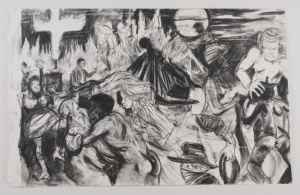|
|
| Line 12: |
Line 12: |
| {{Display censorship incident | | {{Display censorship incident |
| |ongoing=no | | |ongoing=no |
| |year=2016 | | |year=2012 |
| |region=Middle East | | |region=North America |
| |artist=Newsha Tavakolian, | | |artist=Kara Walker |
| |subject=Political/Economic/Social Opinion | | |subject=Political/Economic/Social Opinion |
| |confronting_bodies=Media Development Authority (MDA) of Singapore | | |confronting_bodies=Newark Public Library |
| |medium=Photography | | |medium=Painting |
| |date_of_action=June 2016 | | |date_of_action=December 2012-January 2013 |
| |location=Singapore | | |location=Newark, New Jersey |
| |description_of_content='I Know Why The Rebel Sings' presented highlights from a range of works by Iranian documentary photographer Newsha Tavakolian. It included photographs from her series, 'Look,' 'Listen,' and "The Blank Pages Of An Iranian Photo Album," as well as previously unexhibited images of humanitarian tragedies around the world with a focus on the portrait. The exhibition was part of Singapore International Festival of the Arts (SIFA)'s pre-festival, O.P.E.N. public engagement initiative ("Open, Participate, Engage, Negotiate"). SIFA is the premier national performing arts festival in the country. Tavakolian, best known for her iconic photographs of struggle and conflict, is a member of Magnum Photos and has shot for publications such as National Geographic. | | |description_of_content=The 6-by-9½-foot graphite and pastel on paper is titled ''The moral arc of history ideally bends towards justice but just as soon as not curves back around toward barbarism, sadism, and unrestrained chaos'' (2010), represents black life in the South. Lynchings, the burning of a cross, Ku Klux Klan members, and sexual violence are all shown in the image. |
| |description_of_incident=When the Media Development Authority (MDA) of Singapore initially refused to grant permits for 33 of the photos, the Festival Director Ong Keng Sen and the show's curator, Vali Mahlouji, agreed on a smaller selection to be exhibited. But before opening night, the MDA censored 15 of a larger group of photographs hung against a backdrop of a map of the conflict region, replacing each with a black paper rectangle. The photos belong to the series 'On the War Trail,' depicting photos of Kurdish female soldiers fighting ISIS that are part of the YPJ, an all-woman offshoot of the Kurdistan Workers' Party which the Turkish government (along with United States, Japan and Australia, and several other countries) considers a terrorist organisation. The photographs were commissioned by Time Magazine. Festival director Sen issued a statement condemning MDA's move, pointing out that the photographs were already published in Time Magazine and were widely accessible both online and off. "And so we are living with a new terror where we don't know, it is out of our control," he said at the exhibition's launch. [from "Ong Keng Sen on censorship at Newsha Tavakolian's I Know Why the Rebel Sings," June 22, 2016]
| |
| |description_of_result=The show remained up for the duration with the blacked-out photographs.
| |
| |image=Tavakolian.jpg
| |
| |source=http://www.straitstimes.com/lifestyle/arts/removed-images-photographer-deeply-disappointed
| |
| }}
| |
| [https://sifa.sg/theopen/blog/Statements-from-Newsha-Tavakolian-and-Ong-Keng-Sen-on-censorship/ Statements from Newsha Tavakolian and Ong Keng Sen on censorship, by Ng Yi-Sheng, July 02, 2016]
| |
|
| |
|
| [https://faerieimps.blogspot.com/2016/06/i-know-why-rebel-sings_24.html 'i know why the rebel sings', June 24, 2016]
| | Walker commented: “The work is not about slavery so much as it conjures horrors of reconstruction and 20th-century Jim Crow-ism and the Tea Party. I wanted to make a point about the way these images arose for many when Barack Obama (pictured at a little lectern on the mid-left) gave his national speech on race. And the many times he invokes his or his wife’s heritage to make an ideological point about American patriotism, which in some way grants permission to the ghosts of racist terrorism to be reimagined—here with KKK hooded figures, lynched bodies and sexual violence—and these should be horrible to behold, and should feel both familiar and uncomfortable.” |
| | |description_of_incident=An artwork by Kara Walker on loan to the Newark Public Library from Scott London, a New York-based art collector, offended some library employees, especially African-Americans, who requested its removal. The drawing was then covered with a cloth: the piece was installed Nov. 19, and hidden by Nov. 24. |
| | |description_of_result=Library director Wilma Grey uncovered the drawing. “I’m going to leave it that way,” Grey said. “Several people have suggested I turn this into a teaching moment. Most librarians are very much opposed to censorship and I’m in that camp. We’ll have a staff meeting very soon. There’s so much for people to learn about Walker and her work and about intellectual freedom.” (''Art in America'', Dec 11, 2012). |
|
| |
|
| [https://www.sifa.sg/theopen/blog/i-know-why-the-rebel-sings-by-newsha-tavakolian I Know Why the Rebel Sings, by Newsha Tavakolian, by Ng Yi-Sheng, June 23, 2016]
| | Library officials then planned to create an informational handout at the library, and open a discussion about the work with employees to stir debate and spur conversation. |
| | | |image=Art.jpg |
| [https://bakchormeeboy.com/2016/06/23/i-know-why-the-rebel-sings-sifa-the-o-p-e-n-2016/ I Know Why The Rebel Sings – SIFA: The O.P.E.N. 2016, June 23, 2016]
| | }} |
| | | [https://www.artinamericamagazine.com/news-features/news/kara-walker-newark-library Kara Walker Artwork Censored at Newark Library], by Brian Boucher. Art in America, Dec 11, 2012 |
| [https://sifa.sg/sifa/blog/Ong-Keng-Sen-on-censorship-at-Newsha-Takavolians-I-Know-Why-the-Rebel-Sings/ Ong Keng Sen on censorship at Newsha Tavakolian's I Know Why the Rebel Sings, by Ng Yi-Sheng, June 22, 2016] | |
| | |
| [http://www.newshatavakolian.com/ Newsha Tavakolian Photography]
| |
| | |
| [https://www.magnumphotos.com/photographer/newsha-tavakolian/ Newsha Tavakolian on Magnum Photos]
| |
|
| |
|
| [https://www.instagram.com/newshatavakolian/?hl=en Newsha Tavakolian, Instagram] | | [http://ncac.org/video/kara-walker-and-wilma-grey-on-free-expression Kara Walker and Wilma Grey on Free Expression], NCAC, Nov 20, 2013 |
|
| |
|
| [https://en.wikipedia.org/wiki/Newsha_Tavakolian Newsha Tavakolian, Wikipedia]
| |
|
| |
|
|
| |
|
